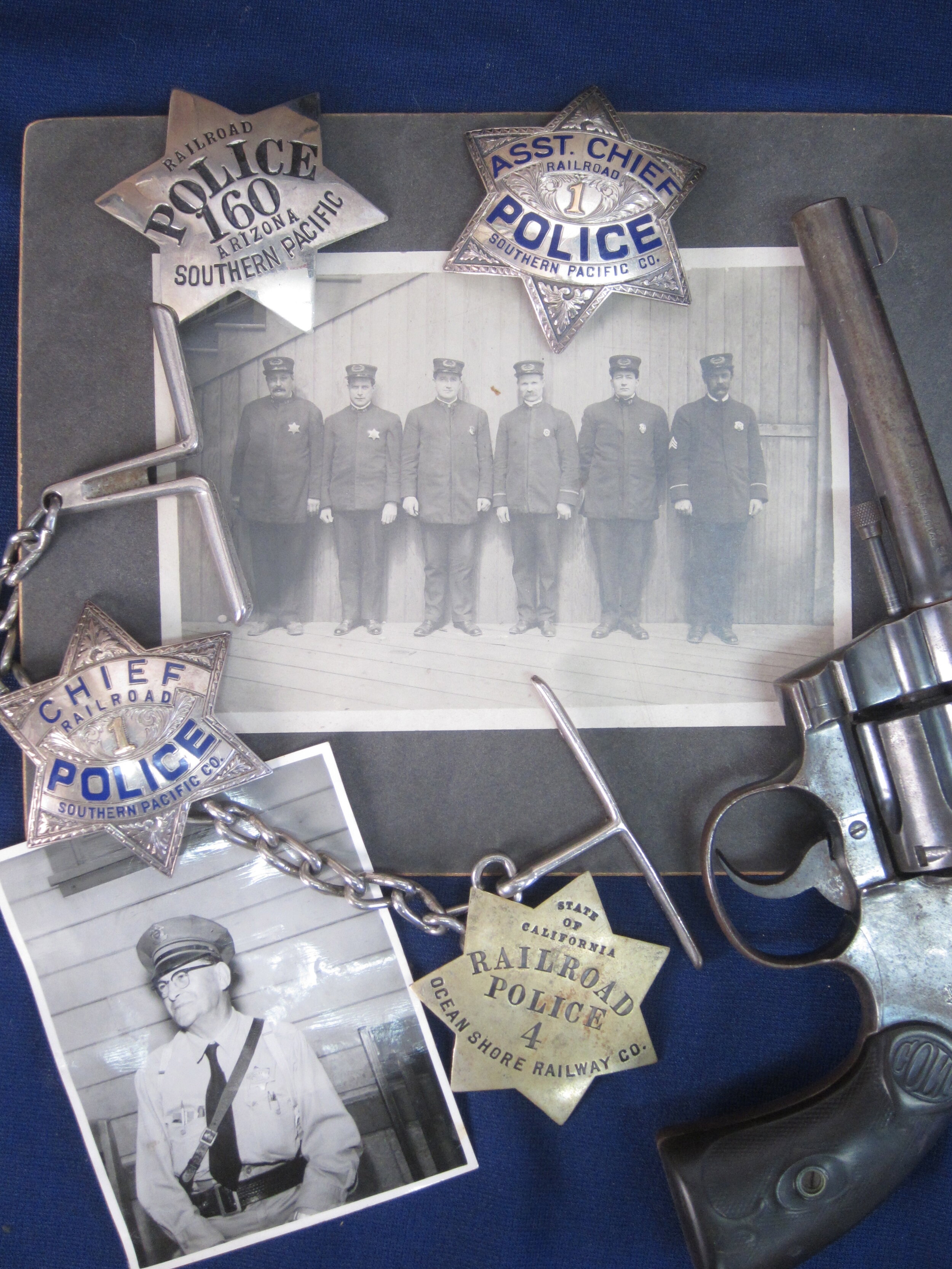
Early 1940's (World War II) picture of Central Railroad Company of New Jersey Patrolman Joseph Leary and an unidentified Jersey City Police Patrolman at the freight and warehouse complex at the Jersey City Railroad Terminal. Note the custom die JCL Patrolman breast and cap badge on Patrolman Leary's long wool dress coat.
In this July 22, 1934 photograph we find New York Central Railroad Police Sergeant Alfred Textar (on right) in uniform conferring with New York Central Railroad Police Detective Lieutenant Joseph Malone about a fatal motor vehicle accident that occurred at the Ossining, New York Railroad Station. They are holding the straw dress hat that belonged to one of the deceased. Note the custom die NYC System clamshell Sergeant's badge on Sgt. Textar's uniform blouse.
The history of policing on the railroads can be traced back to 1847 when the Baltimore & Ohio Railroad requested the City of Baltimore to issue Special Police Commissions for men hired as Detectives. By 1860 over 30,000 miles of railway track spanned the United States. There was little organized law enforcement, and even less was available to protect the passengers and freight carried across the country using this new mode of transportation. The United States Marshals, which agency had primary jurisdiction in many cases, were few and far between in the wilderness. Railroad companies were left in large part to protect themselves from robbery, sabotage and theft. Contract railroad police gradually appeared, usually bearing the title of "Special Agent" or "Detective". Two of the most famous of these new detectives were "Bat" Masterson and Allen Pinkerton. Over the years many famous gangs of outlaws, as well as many lesser-known criminals, preyed upon the railroads. The James and Younger gangs, the Daltons, the Hole in the Wall gang and the Wild Bunch are among the best known.
The hiring of individuals was done with little regard for their background. What was important was that they could ride, track well and shoot straight if called upon to. The law enforcement "profession" was far from it in those days. Many men appointed as peace officers had been on the other side of the law at one time or another. The line between the lawman and the outlaw was blurred. Over the years, many thugs and undesirable characters became Railroad Police Officers.
In those days, it was the general custom to simply hand a newly appointed officer a badge and send him out into the field without further instruction in the law or how it was to be enforced. The manner in which these men did their job was largely up to each individual. This method of selecting agents, and the lack of training and discipline, tainted this branch of railroad service for many years. Many times heavy handed, railroad police came to be known as "bulls" "goons" and "yard cops" and had a generally poor reputation among the communities along the rails. In response, the railroads began contracting with professionals. Most notable among these was the Pinkerton Agency. Although more professional, and less corruptible, the contractors were always looked upon as "outsiders" in the eyes of railroad employees. This in many cases led to poor cooperation and a perpetual atmosphere of mistrust.
On February 27, 1865, the legislature of Pennsylvania enacted the Railroad Police Act -- the first such legislation officially establishing and sanctioning railroad police. This act authorized the governor of the state to appoint railroad police officers, and gave these officers statewide authority. It provided the model legislation that virtually every other state in the nation has followed. In 1989, Railroad Police were given interstate authority under US Code 49: 28101
Today's railroad police officer is highly trained and tested. He is a hybrid individual as he needs to know railroading as well as law enforcement. A railroad police officer may be confronted at any time with situations that require a learned and proper response, and basic academy training is the foundation of the proper response. Hiring standards are as stringent as for any city, county or state law enforcement position. Officers also take advantage of in service and advanced officer training offered through the many regional police academies to broaden their skill sets and sharpen their techniques.
From tracking and taking down a crew of cargo thieves or investigating grade crossing collisions to verifying seals on freight cars or presenting the ongoing message of railroad safety to a group of school children, the railroad police officer must be a master of all facets of the law enforcement mission.
Railroad Policemen carry a badge, either a shield or star as a symbol of their authority. These badges have changed over the years from simple nickel or copper stamped pieces, solid gold or sterling silver engraved ones to custom die badges with beautiful enameled logos. They have one thing in common, they tell the story of a brave group of lawmen who protected this nations railroads, passengers, and employees throughout the years.
It is for those reasons that I collect railroad police badges. For further discussion, visit the Railroad Police History Group on Facebook!

